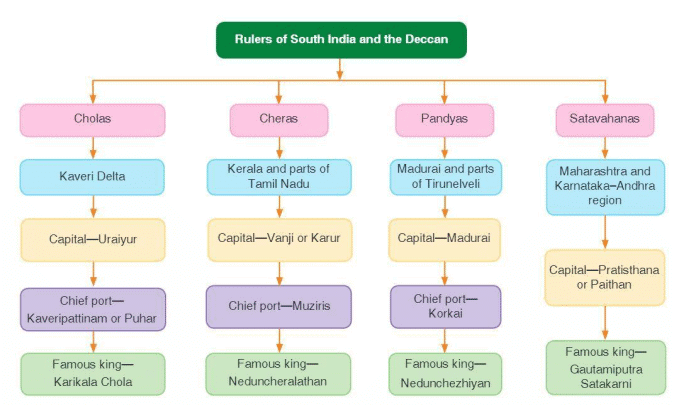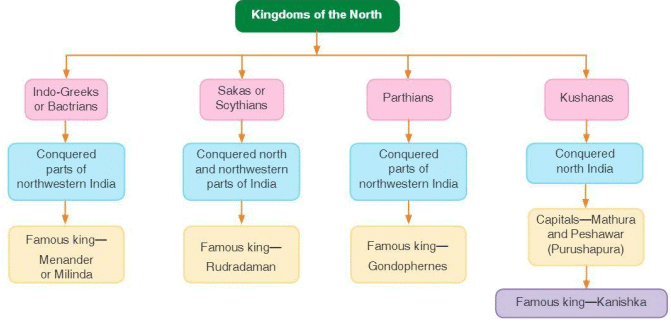Class 6 Exam > Class 6 Notes > History Class 6 ICSE > Chapter Notes: The Post- Mauryan Period
The Post- Mauryan Period Chapter Notes | History Class 6 ICSE PDF Download
| Table of contents |

|
| Introduction |

|
| Kingdoms in the North |

|
| The Silk Route |

|
| Spread of Buddhism |

|
| The Beginning of Bhakti |

|
Introduction
After the Mauryan Empire ended in 185 BCE, India saw the rise of new kingdoms in the north and south. The Sunga and Kanva dynasties briefly ruled before various regional powers emerged. Foreign tribes from Central Asia, like the Bactrians, Sakas, and Kushanas, established kingdoms in the north, while south India saw the rise of the Cheras, Cholas, Pandyas, and Satavahanas. This period was marked by flourishing trade, especially along the Silk Route, and the spread of Buddhism and the beginning of Bhakti. Sangam literature provides valuable insights into south Indian society, culture, and history during this time.Sangam Literature
- Sangam literature refers to early Tamil works composed in assemblies of poets in Madurai, called sangams.
- The term "muvendar" means "three crowned kings," referring to the Chola, Chera, and Pandya dynasties ruling Tamilakam (modern Tamil Nadu and Kerala).
- Three sangams were held, but most of their works are lost.
- Existing Sangam poems provide details about life, culture, and society in ancient south India.
- Occupations are mentioned, but caste is not directly referenced.
- It is a key source for studying ancient south Indian history.
Rulers of South India and the Deccan

The Cholas
- Ruled the Kaveri delta with their capital at Uraiyur.
- Kaveripattinam (Puhar) was their major trading port.
- King Karikala Chola, meaning "the one with the charred leg," was a prominent ruler.
- Karikala defeated the Cheras, Pandyas, and even occupied parts of Sri Lanka.
- He promoted trade and built many roads.
- The Chola emblem was the tiger.
- Kaveripattinam was destroyed by a tsunami 1500 years ago, as mentioned in the Tamil text Manimekalai, due to the king’s failure to conduct a festival, angering the sea goddess.
The Cheras
- Ruled present-day Kerala and parts of Tamil Nadu, with their capital at Vanji (Karur).
- Also known as Keralaputras by historians.
- Had trade links with Romans and Greeks.
- Muziris was their chief port.
- King Neduncheralathan was famous and fought against the Cholas and Pandyas.
The Pandyas
- Ruled Madurai and parts of Tirunelveli, with their capital at Madurai.
- Korkai was their chief port.
- King Nedunchezhiyan was a notable ruler who defeated the Cholas and Cheras.
- He was a great patron of art and literature, and the third sangam likely occurred during his reign.
- The Pandyan kingdom was famous for exporting pearls to Rome.
- Frequent conflicts occurred among the Cheras, Cholas, and Pandyas.
The Satavahanas
- Ruled present-day Maharashtra and Karnataka-Andhra regions, with their capital at Paithan (Pratisthana).
- Gautamiputra Satakarni was the most significant ruler, known for establishing a prosperous kingdom.
- His mother, Gautami Balashri, mentioned his achievements in inscriptions.
- Known as "Lords of the Dakshinapatha" (route to the south).
- Had flourishing internal and external trade, including with the Roman Empire, as evidenced by Roman coins found in their kingdom.
- Women held important societal roles, and dance was popular, as shown in sculptures.
- Worshipped Hindu gods and built rock-cut temples and monasteries in Maharashtra.
Kingdoms in the North

Indo-Greeks or Bactrians
- Ruled northwestern India by the 2nd century BCE after the decline of Seleucid power.
- King Menander (Milinda, 166–150 BCE) was the most famous, converting to Buddhism.
- The book Milinda Panha records his discussions with Buddhist philosopher Nagasena.
- Indo-Greek coins featured kings’ portraits and inscriptions in Greek and Kharosthi scripts.
- Indian art and craft were influenced by Greek styles, leading to the Gandhara School of Art, combining Indian and Greek elements.
The Sakas or Scythians
- Central Asian tribe that controlled north and northwestern India.
- King Maues (80 BCE) established Saka power in Gandhara.
- Their kingdoms were divided into provinces under military governors and satraps.
- King Rudradaman was notable, using Sanskrit for inscriptions instead of Prakrit.
The Parthians
- Came from Iran and ruled parts of northwestern India.
- King Gondophernes was the most famous.
- During his reign, Saint Thomas is said to have visited India and spread Christianity.
The Kushanas
- Emerged in the 1st century CE with a vast empire, having capitals at Mathura and Purushapura (modern Peshawar, Pakistan).
- King Kanishka was the most famous, a follower of Buddhism.
- He organized the Fourth Buddhist Council in Kashmir to discuss Buddhist issues.
- Supported cultural activities, art, and Sanskrit literature, including the Gandhara School of Art.
- Ashvaghosha, a Sanskrit scholar, lived in his court and wrote Buddhacharita, a biography of the Buddha.
- Issued gold, silver, and copper coins, among the earliest gold coins in India.
- A headless statue of Kanishka, depicting him in a tunic, topcoat, boots, and holding a sword and club, is in the Mathura Museum.
The Silk Route
- A major trade route named after silk, a highly valued commodity among Romans.
- The Chinese were the first to produce silk, keeping the technique secret for years.
- Traders traveled through various routes, collectively called the Silk Route, with multiple branches.
- Kushanas controlled a branch extending from Central Asia to the Indus River ports, sending silk to Rome by ships.
- Merchants and Buddhist monks used the route, aiding the spread of Buddhism.
Spread of Buddhism
- Buddhism was popular, patronized by rulers like Menander and Kanishka.
- Spread to other countries due to India’s trade and cultural contacts, starting with Ashoka’s missions.
- Buddhism split into Hinayana (older, using symbols like the Bodhi tree) and Mahayana (depicting Buddha in human form).
- The concept of Bodhisattvas emerged—enlightened beings who stayed to help others.
- The Silk Route aided Buddhism’s spread to China, Central Asia, Korea, Japan, Thailand, Indonesia, Myanmar, Java, Cambodia, Sumatra, Vietnam, and Sri Lanka.
- Afghanistan was a key Buddhist center, with the Bamiyan Buddha statues (destroyed in 2001) as evidence.
Foreign Travellers
- Traders, pilgrims, and missionaries traveled the Silk Route.
- Chinese pilgrims Fa-Hien (5th century CE, during Chandragupta II’s reign) and Hiuen Tsang (7th century CE, during Harshavardhana’s reign) visited India to study Buddhism and collect texts.
- Fa-Hien stayed at Pataliputra and translated Buddhist texts in China.
- Hiuen Tsang studied at Nalanda University, took manuscripts and Buddha statues to China, but lost some when his boat capsized on the Indus River.
- Indian monk Kumarajiva traveled to China, translating Buddhist texts into Chinese.
- Nalanda University in Bihar was a major Buddhist learning center, attracting scholars from China, Greece, and Persia.
- Nalanda had 2000 teachers, 10000 students, a vast library, and was a residential university for men.
- It was destroyed three times, finally by Bakhtiyar Khilji in 1193 CE, and rebuilt twice.
The Beginning of Bhakti
- Hinduism grew alongside Buddhism, with worship of deities like Vishnu, Shiva, Durga, and Parvati.
- Rituals and sacrifices became less important, replaced by the concept of bhakti (devotion to God).
- Bhakti required a pure heart, accessible to all regardless of wealth, gender, or class.
- The term "bhakti" comes from Sanskrit "bhaj" (to divide or share), indicating a two-way relationship between devotee and God.
- Mentioned in the Bhagavad Gita, part of the Mahabharata.
- Devotees believed pure devotion allowed them to see their deity in their desired form.
Meanwhile
- Christianity emerged 2000 years ago in West Asia, founded by Jesus Christ, born in Bethlehem (Roman Empire).
- Christians follow the Bible, and Jesus is seen as the Saviour of the World.
- His teachings spread through West Asia, Africa, and Europe.
- In India, Christianity arrived in Kerala via Saint Thomas, an apostle who propagated the faith.
- Syrian Christians of Kerala are among the oldest Christian communities globally.
The document The Post- Mauryan Period Chapter Notes | History Class 6 ICSE is a part of the Class 6 Course History Class 6 ICSE.
All you need of Class 6 at this link: Class 6
|
24 videos|55 docs|12 tests
|
FAQs on The Post- Mauryan Period Chapter Notes - History Class 6 ICSE
| 1. What is Sangam Literature and why is it significant in Indian history? |  |
Ans.Sangam Literature refers to a body of ancient Tamil texts composed during the Sangam period (approximately 300 BCE to 300 CE). It is significant because it provides insight into the culture, politics, and social life of South India during this time, including themes of love, valor, and morality. The poetry reflects the rich linguistic heritage and the early forms of Tamil literature.
| 2. Who were the major rulers of South India during the Post-Mauryan period? |  |
Ans.During the Post-Mauryan period, major rulers in South India included the Chola, Chera, and Pandya dynasties. These kingdoms played a crucial role in the political landscape of South India, contributing to advancements in trade, culture, and administration, and they were known for their patronage of the arts and literature.
| 3. What role did the Silk Route play in the cultural exchanges of ancient India? |  |
Ans.The Silk Route was a network of trade routes that connected the East and West, facilitating the exchange of goods such as silk, spices, and precious stones. It also enabled the spread of ideas, culture, and religions, including Buddhism, which traveled from India to Central Asia and beyond, influencing various civilizations along the route.
| 4. How did the spread of Buddhism impact society in ancient India? |  |
Ans.The spread of Buddhism in ancient India led to significant social changes, including the promotion of ideas like non-violence, compassion, and equality. It attracted a diverse following, including those from lower castes, and contributed to the establishment of monasteries and educational institutions, which played a vital role in the dissemination of knowledge.
| 5. Who was Ashvaghosha, and what was his contribution to Indian literature? |  |
Ans.Ashvaghosha was a 1st-century CE Indian poet and philosopher, known for his Sanskrit plays and poetic works. His most famous contribution is the "Buddhacharita," a biographical narrative of the life of Buddha, which combines literary excellence with spiritual teachings, influencing subsequent Buddhist literature and thought.
Related Searches














